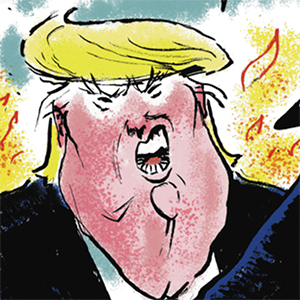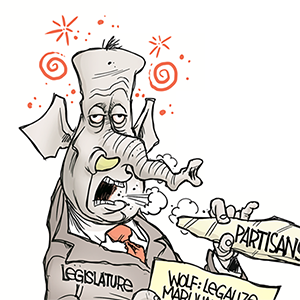Threatening texts targeting minorities after election were vile − but they might not be illegal
Published in Political News
The FBI and police in several states are investigating a wave of hateful texts and emails apparently targeting minorities across the United States following the presidential election.
The anonymously sent messages, which may have numbered up to 500,000, varied in their specific language but had similarly menacing themes. Some referred to recipients as “selected for slavery” and ordered them to a plantation to pick cotton. Others said they’d be picked up for deportation or sent to a reeducation camp.
The threats lacked details on timing, location and the like. Some addressed recipients by name, while others contained no greeting or personal identifier. They seemed to be targeting Black people, immigrants and LGBTQ people but may have been dispatched indiscriminately to a wide swath of Americans.
Information technology experts have expressed confidence that the perpetrators will be identified. Yet it’s not clear to me as a professor of constitutional and criminal law that they can be prosecuted. The First Amendment generally protects free speech, even when it’s heinous.
Several Supreme Court decisions have established that speech may not be punished just because it is offensive or hateful.
“If there is a bedrock principle underlying the First Amendment, it is that the government may not prohibit the expression of an idea simply because society finds the idea itself offensive or disagreeable,” the justices wrote in Texas v. Johnson, a 1989 case that affirmed flag burning is protected expression.
Snyder v. Phelps, a 2010 case involving anti-LGBTQ protesters who carried hateful signs at the funerals of fallen soldiers, strengthened that precedent.
“Speech is powerful. It can stir people to action, move them to tears of both joy and sorrow, and – as it did here – inflict great pain,” the justices wrote. Nonetheless, they concluded, “We cannot react to that pain by punishing the speaker. As a Nation we have chosen a different course – to protect even hurtful speech.”
The Supreme Court has been cautious in recognizing exceptions to the freedom of speech because of its importance to democracy and individual autonomy. Under special circumstances, however, some types of speech can be illegal.
One recognized exception is a “true threat.”
In the 2023 case Counterman v. Colorado, the Supreme Court held that for speech to cross over the true threat line, the speaker must both express an intent to commit violence and recklessly disregard “a substantial risk that his communications would be viewed as threatening violence.”
An example of a true threat under the Counterman case would be for a scorned lover to barrage their ex with messages promising to kill or maim them.
This standard is so new that it has not been tested thoroughly in the lower courts, making predictions risky at best. In my analysis, however, a message mass distributed to thousands of recipients indicating that they had been “selected” to be a slave might not meet the Counterman standard.
Additionally, “slave” is a legal status that hasn’t existed for over 150 years, so the threat to force someone into enslaved labor likely lacks both the peril of physical harm and the plausibility of harmful action. The anonymity of the senders may add to this implausibility.
Courts may also find that the communications didn’t create a “significant” risk that a “reasonable” recipient would feel threatened. An anonymous mass message may be interpreted as spam, or trolling.
Accordingly, the messages probably would not rise to the level of “true threat” exceptions to First Amendment protections.
Other exceptions recognized by the Supreme Court are speech that incites others to imminent lawlessness and “fighting words.”
Yet the November messages didn’t call others to violence, nor were their words likely to provoke it – the two hallmarks of incitement. “Fighting words,” meanwhile, require face-to-face communication that is likely to incite a violent reaction. This did not happen in the November messages, either.
There’s another problem with any legal case against the culprits behind the November messages: What crime would they even be charged with?
The law enforcement officials who’ve pledged to get to the bottom of the matter have expressed outrage and concern, but they have not identified what law they believe was broken.
Ohio Attorney General Dave Yost is an exception.
“Other people have no First Amendment right to your phone, and free speech doesn’t protect telephone harassment,” Yost said in a post on X on Nov. 7 when he opened an inquiry into the hateful texts received by an an unspecified number of Ohioans.
Yost was likely referring to a 2011 Ohio statute that criminalizes telecommunications that are “threatening, intimidating, menacing, coercive, or obscene with the intent to abuse, threaten, or harass the recipient.”
The intersection of telephone harassment and the First Amendment is less clear, in my analysis. Laws vary by state, but illegal harassment and stalking typically involves physical conduct, which is not protected by the First Amendment – for example, repeated unwanted visits to someone’s home or workplace. Continually following someone in a manner intended to cause fear – or which recklessly causes fear or emotional distress – would be another example.
Could a text or email be characterized as conduct rather than speech? That is unsettled law. And where the law is unclear, novel legal strategies can set a new precedent.
If a court were to decide that the act of sending the November messages was “pure conduct,” rather than protected speech, then anti-harassment laws might be used to prosecute the senders.
Criminal law aside, people are not powerless against vile communications.
Telecommunications companies are free to block messages, both before they are received and in response to customer requests. After the wave of hateful texts in November, many did just that by closing accounts identified as sources of those messages.
If a blocked sender continues to send similar communications to a target, the elements of harassment would be met. A court could determine that to be expressive conduct or simply speech not protected by the First Amendment.
The U.S. draws the boundary widely around free speech because it enables wide, controversial discussions of politics, law and society. In this case, the senders ran up to the line of protected speech but quite possibility didn’t cross it.
“The trouble with fighting for human freedom is that one spends most of one’s time defending scoundrels,” the author H.L. Mencken once said. “For it is against scoundrels that oppressive laws are first aimed, and oppression must be stopped at the beginning if it is to be stopped at all.”
This article is republished from The Conversation, a nonprofit, independent news organization bringing you facts and trustworthy analysis to help you make sense of our complex world. It was written by: Daniel Hall, Miami University
Read more:
Supreme Court to consider giving First Amendment protections to social media posts
Americans love free speech, survey finds − until they realize everyone else has it, too
Donating to help women get abortions is a First Amendment right – protected by Supreme Court precedents
Daniel Hall does not work for, consult, own shares in or receive funding from any company or organization that would benefit from this article, and has disclosed no relevant affiliations beyond their academic appointment.




























































Comments